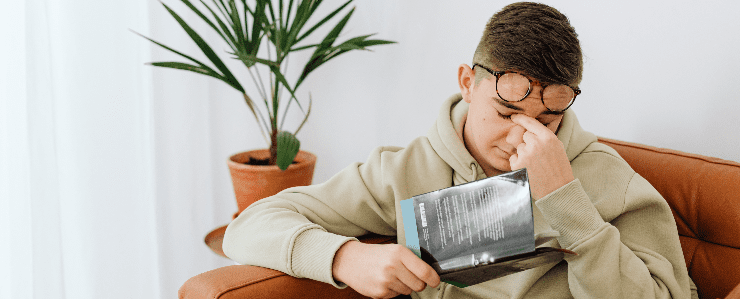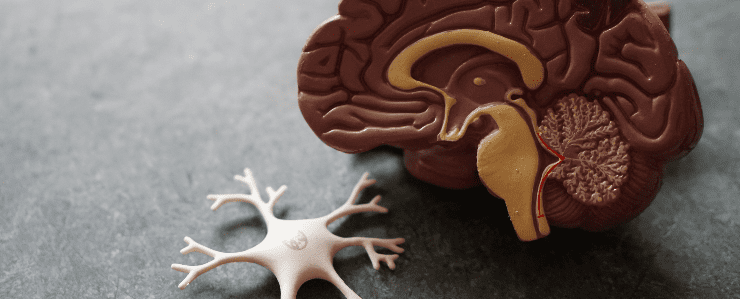What Is a Silent Migraine? What are the causes of silent migraine?

What comes to your mind when you hear the word migraine? Headache, obviously! Most people associate migraines with headaches and aren’t wrong because migraine attacks cause severe headaches. However, there is something called silent migraine or migraine without a headache. But why does it even classify as a migraine if there is no headache?
People who experience silent migraines are said to experience the symptoms of a migraine attack but never experience headaches. A condition like this is difficult to diagnose in the early stage because most of us don’t bother analyzing it after we start feeling better.
In this article below, you can learn more about silent migraines, their causes, treatments, and much more.
Please note: This post is meant to be an informative guide; hence we do not recommend treating yourself without professional medical advice.
What is a migraine aura?
Before we understand silent migraine, let us learn a little about the “aura.” For that, we need to know how migraine attacks occur.
Migraine does not appear out of the blue. It is more than just the headaches that you may experience. Your body does the job of giving you warnings before the attack. It follows a step-wise process as mentioned below.
A migraine attack is a three-phase process.
Phase 1: Prodrome Phase
This phase starts two to four days before the attack, and you can experience some of the following symptoms.
- Sensory organs become sensitive
- Tiredness
- Food cravings
- Frequent mood swings
- Diarrhea or constipation
- Bloating
Phase 2: The aura phase
The aura is nothing but the symptoms of a migraine attack.
Usually, people experience a visual aura, which includes the inability to see things or see flashes of light in front of their eyes or zigzag patterns floating in front of them.
The aura or the symptoms differ based on the type of migraine attack. For example, some people experience brainstem aura, which makes them lose balance and feel dizzy. Our brainstem, which comprises the medulla oblongata, is responsible for maintaining our balance. So if your balance is compromised, it implies that you have a migraine with a brainstem aura. People also experience difficulty in speaking before the migraine attack.
The aura phase of a migraine attack starts approximately an hour or less before the migraine attack.
Phase 3: Migraine Attack or the headache phase
After the aura phase, you will start experiencing severe headaches, typically defining a migraine attack. Migraine headaches are nothing like our usual headaches. Those who experience migraines know how they are painful and hard to tolerate. This pain is why many patients diagnosed with migraine carry painkillers and other oral contraceptives if they start experiencing the previous two stages. Usually, only one side of your brain should be radiating pain. However, there are chances of this pain expanding its territory, causing headaches in other parts of your head. You might also feel nauseated and might have a few episodes of vomit. A migraine attack lasts about 4 hours but can go up to 3 days as well. The aura symptoms can continue to exist even during the attack phase.
There is another phase that comes after the attack.
Phase 4: Postdrome
Postdrome is the phase in which you will experience tiredness or weakness due to the attack phase. It is like a migraine hangover. You should start feeling better after this phase.
What are silent migraines?
Silent migraine or Acephalgic migraine does not cause any headache, but you can observe the aura. It is a migraine with similar symptoms and is as dangerous as the usual migraine. You will experience a visual aura or disturbances in other sensory organs, but it will not lead to a sharp headache.
How to identify if you have silent migraine? Since silent migraine doesn’t have the headache phase, it is hard to notice that you have a migraine.
Since a typical migraine is usually associated with strong head pain, many people unaware of silent migraine ignore the aura they experience. They might think of it as some visual disturbance and let it be because it returns to normal in some time.
Here’s how you can identify that you are having silent migraine. Below are some common symptoms of aura without headache.
Silent migraine symptoms
- Visual disturbances
- Tunnel vision
- Sensitivity to light, sound, and taste (sensory symptoms)
- Seeing zigzag patterns or lines
- Numbness
- Difficulty in speaking
- Vomiting
- Nausea
- Weakness
- Dizziness
Please seek a healthcare professional for advice if you observe any of these symptoms. People who usually have classic migraines can also have migraine without headaches sometimes.
What causes silent migraine?
If you are wondering why there is no headache in silent migraine, sorry to disappoint you, but the real reason is yet to be discovered. The causes of silent migraine are similar to typical migraine and other migraines.
Earlier it was believed that migraines are caused by poor blood circulation in the brain via the blood vessels. Any organ that fails to receive a good amount of oxygen will eventually start causing problems, as does the brain. However, further research found that poor blood circulation is a consequence of improper nerve cell stimulation.
The top part of our brain, also known as the cortex, experiences a reduction in neural activity after excessive nerve cell firing. This reduction in neural activity is thought to be the cause of aura. The cortex region includes:
- Occipital lobe: The part that controls our eyes and our sense of vision.
- Parietal lobe: Responsible for controlling our bodily sensations
- Temporal lobe: Our hearing ability is controlled by this region of the brain.
The malfunctioning of nerve cells in the brain causes a reduction of brain activity in the cortex, which affects the functioning of the occipital lobe, parietal lobe, and temporal lobe, thus causing the aura.
Common triggers of silent migraines
Migraine triggers vary depending on each person’s condition; hence there can be many triggers. Although there aren’t any specific causes, some triggers usually lead to severe migraines. Traditional migraine triggers and silent migraine triggers are more or less the same. We’ll list a few common triggers below.
Food triggers
- Caffeine
- Alcohol
- Fermented items
- Chocolate
- Food items with preservatives
- Food additives
- Products with MSG ( Monosodium Glutamate)
- Some cheeses and soy sauces (containing tyramine)
Environmental triggers
- Strong weird smells
- Changes in weather
- Changes in the air pressure
- Bright lights
- Higher temperatures
- Smoke
- Loud and harsh noises
Lifestyle triggers
- Lack of sleep
- Stress
- Depression and anxiety
- Experiencing too much excitement
- Exertion
- Some medications like contraceptives and sleep medications
- Not drinking enough water
- Skipping meals
Body issues as triggers
- Neck pain
- Sinus
- Eye strain
- Hormonal changes
- Menopause
- Muscle tension
- Family history
Risk Factors for Silent Migraines in Women
You are a woman
According to WHO, women are at a larger risk of migraines because of the female hormones and hormonal changes that women experience.
You are under the age of 40
Individuals under 40 have a higher risk of developing migraine or silent migraines.
Menstruation, menopause, and pregnancy
Women undergo many hormonal changes during menstruation, menopause, and pregnancy. Moreover, stress levels increase during these periods.
Family history
If your parents and grandparents had migraines, you are also more likely to have them.
Treatment Options for Silent Migraines
You cannot completely cure migraines, they are incurable, but you can treat them to reduce how they affect your daily life. You can use the following treatment methods to help minimize headaches and the frequency of migraines.
Medicines
Healthcare professionals usually recommend painkillers to help patients manage pain during a migraine attack. However, there are some other medications that you might come across.
Here’s a list of a few medications that can help you.
We urge you to see a healthcare provider before consuming these medications. Each body is different, and what works for some might not work for others.
- Painkillers like ibuprofen
- Triptans to improve blood flow into the brain (e.g., Naratriptan)
- Ergotamine for people who have migraine attacks for two or a few days more ( do not use it for regular stress and headache)
- Anit-nausea medications are given to patients to prevent nausea from disturbing the effect of other migraine medications.
- Beta-blockers like Propranolol help reduce the frequency of migraine attacks. They also help reduce your blood pressure.
- Antidepressants help reduce the levels of several neurochemicals, including serotonin, to ease migraine headaches.
- Anticonvulsants are used to ease nerve cells.
Massage therapy
Massage therapy uses carefully calculated massages to treat the tissues in our muscles. Massage is said to improve blood circulation; hence it can help you with migraine. Moreover, it lets one get better sleep, further reducing the chances of migraines.
Massage therapy can help reduce stress, which is also a major cause of migraine.
There are different techniques used by professionals based on your requirements. You can either have a mild relaxing massage or go for an intense massage to ease muscle tension. Some professionals also use stones for messages. Get in touch with some professionals and discuss your health condition before you get treated.
Acupuncture
Acupuncture is a Chinese therapy that uses needles to reduce pain and stress. These needles are entirely different from the needles we have at home. Acupuncture needles are very thin and long. The professionals will insert needles into your skin to reach the target points.
A study done in 2016 with around 5000 participants proves that acupuncture is a very effective method of reducing the frequency of migraine and pain during the headache phase. 41% of people experienced a reduced migraine attack frequency to half. Both massage and acupuncture are proven to be safe and effective migraine treatments.
Acupuncture reduces pain and inflammation, further helping you with pain management.
Identifying and avoiding triggers
Something that you can do on your own is to avoid the triggers. For example, if your migraine is triggered by caffeine, avoid consuming coffee and other products containing caffeine, like chocolates.
But how do you identify triggers?
Migraine triggers are different for each individual. Moreover, it is not always one thing that triggers migraine. If a few triggers occur simultaneously, your body crosses the trigger threshold, and you experience a migraine attack.
It is difficult to identify our triggers but not impossible. Identifying triggers itself is a headache. It would require you to give a lot of attention to yourself, which we hardly ever do. Moreover, one trigger is never the reason. For example, caffeine, stress, and heavy exercise cause your body migraines. Sometimes, when you are having coffee, you may not get a migraine because you may not be under any stress or maybe did not do a high-intensity workout.
An easy way to figure out what triggers migraine in your body is by maintaining a diary. Just start noting what you ate or experienced before experiencing the aura. Once you have done this a few times, observe the patterns. Do you get an attack every few days? Do you get it only when you are stressed? Do you get it when you have alcohol? Observe the patterns and start avoiding those triggers.
Improving lifestyle
Stress, hormone level, blood pressure, anxiety- all of these migraine triggers can be reduced by adopting a good lifestyle. By improving your lifestyle, you can reduce your stress and also improve your hormonal balance.
What how does a good lifestyle look like?
- You get enough sleep
- You go to bed early
- Regular exercise ( as much as you can do, don’t force yourself too much)
- Eat a balanced diet
- Avoid caffeine
- Mediate occasionally
- Stay happy and stress-free
Bottom Line
Migraines are incurable, they will never go away entirely, but you can always control the frequency and the pain. Meet a healthcare provider if you notice any aura symptoms, whether you experience a headache or not. Read health articles to improve your knowledge and discover new pain management methods. You can always use massage therapies and other safe methods, but before doing anything else, consult a physician.




